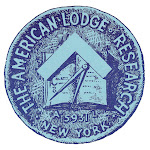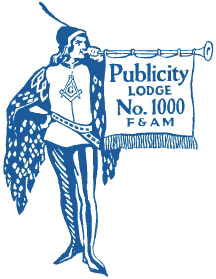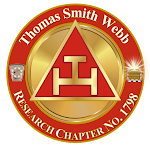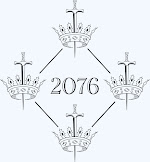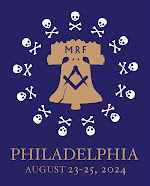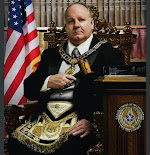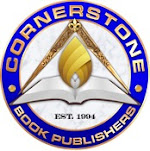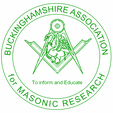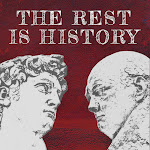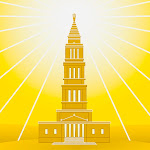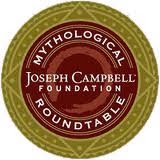 |
| Digitized proceedings from A to W. (Mark Tabbert photo) |
Tuesday, December 7, 2021
‘Who, What, When, Where, and sometimes Wyoming’
It seems like it wasn’t even a year ago that I updated you on the digitization project underway by the George Washington Masonic National Memorial, and word came today that the work will be completed this week.
Mark Tabbert shared the good news several hours ago, explaining how the Wyoming Grand Commandery books of proceedings will be the last of the texts to be scanned and saved for eternity as searchable digital files. Well, he didn’t mention eternity. That’s just my excitement pulsing through. And I am excited because these official, published records of our grand lodges, grand chapters, etc. are big parts of the first draft of history.
When researchers like us want to get an idea of something that happened in our past, these texts are invaluable. Maybe you seek a hard fact, like the number of cigars donated in 1919 to the residents of the California Masonic Home (750). Perhaps you’re studying something that’s more of a trend, such as expulsions of Masons for being drunks or bad husbands. (Those were the days.) Or statistics might be needed. (Wisconsin’s lodges collectively rejected 294 petitions in 1875.) These books contain such data and a lot more.
Naturally, they’re written by people, so you’ll have to anticipate some errors and some very deliberate omissions, but we have to start somewhere. And somewhere is right here.
For this to happen, our grand lodges and other governing bodies must pay a nominal fee of $1,000 for the initial set-up costs, and then a thousand annually to maintain the online access to their books, so if your Freemasonry isn’t included among these digital documents, maybe tell your Grand Ones to cough up the dough and preserve the archives of Masonry from inundations and conflagrations. As Mark says, the work is done already; only the uploading is required now.
(Of course, we New York Masons have our own thing, as you might expect of us.)
Monday, December 6, 2021
‘Familiar looking coin found in Jerusalem’
There is something going on lately with amateur archeologists unearthing ancient coins. It seems hardly a month passes without some guy with a metal detector finding a cache of Roman or Saxon or some other gold and silver in Britain. A few weeks ago, a child volunteering at a dig in Jerusalem brought to light a 2000-year-old shekel that should look familiar to Mark Master Masons.
Liel Krutokop, age 11, plunged her fingers into her very first bucket when a round object made itself conspicuous amid the dirt taken from the City of David area. It turned out to be a shekel of pure silver dating to 67 or 68 C.E.—The Great Revolt—when Judea was in rebellion against the Roman Empire.
 |
| Coil’s Masonic Encyclopedia |
I’m assuming whoever lost this coin two millennia ago had some explaining to do when he got home.
Congratulations Miss Krutokop!
Saturday, December 4, 2021
‘Invitation to interview’
The Magpie Mason hereby invites Bro. Gary Olsen, past senior grand warden of the grand lodge of New Jersey, to share his side of the story in an interview that would result in a news article for a future edition of The Magpie Mason. I can be contacted here. Contact has been made; powerful allegations have been leveled; I continue to seek an interview. Fuggedaboutit. I just (3/4/22) learned who some of Olsen’s intended grand staff appointees were. My offer is retracted.
Olsen was removed from his station in the Grand West of that grand lodge earlier this week by its grand master who did so by edict.
I am promising an impartial hearing of the brother’s account of events, an article fairly balancing his views and other information I have researched, and a readership far larger than any other available to him in Masonic cyberspace. I guarantee everyone in New Jersey who might be interested in reading the story will read it (in addition to the usual multitudes across the country and beyond).
I know what happened and why, so I would ask tough questions, but I will be fair in presenting the facts.
Olsen and I do not know each other and never have met, so it’s understandable if he has no interest in this proposition. Do not think negatively of him if he declines or doesn’t reply, but don’t believe for a second that he won’t see this invite.
As for the grand lodge of New Jersey, I am not a member. And there’s a lot more I could say about it.
Friday, December 3, 2021
‘Not necessarily the news’
 |
| Courtesy WickedDesigns1 |
There was a time—and this wasn’t a million years ago—when the sacking of a top officer of a Masonic grand lodge would have been news. It would have “made the papers.” It would have been covered by the newspaper that you read daily. This edition of The Magpie Mason is in reminiscence of a much larger time, an era when our discreet Masonic fraternity was publicly consequential because of its vast membership, because its executive leaders were admirably newsworthy in their professions and communities, and—not for nothing, but—because of the prestige that is born of self-respect.
Yesterday, the grand master of the grand lodge of New Jersey evicted from office the senior grand warden of the grand lodge. That’s a fact, but that’s all I’m going to say about it because it’s the only fact of the matter I possess. (I was chastised on Facebook last night by a friend of many years who complained that I’m too negative! I know, right? Crazy.)
If you’re ever struggling to fall asleep, you could read the books of proceedings of this grand lodge. They are stenographic melatonin. I’m having a hard time putting my finger on the right volumes, but somewhere around fifty years ago, there were Grand Masters of the Grand Lodge of New Jersey who were invited to broadcast media studios for the purpose of discussing things Masonic. I think it was WOR in each situation, but the Most Worshipfuls appeared on both radio and television, according to those books.
Can you imagine such a thing happening this morning? Not necessarily.
I’m at labor in a New York City lodge named Publicity, founded in 1922 by the biggest big shots of Madison Avenue, plus numerous publicists and journalists, and I can’t picture my Grand Masters—past, present, or future—being interviewed about Masonry for the heck of it, even in this age of innumerable media platforms, and almost all those Masons are awesome!
(I don’t mean to write about the English for the umpteenth time, but the UGLE employs a professional communications team, so their grand guys are in the good news very often lately, but that’s a whole other dynamic.)
The obscurity of Freemasonry in the public consciousness today hurts us not only in the obvious ways that a lack of positive publicity depresses everything from morale to membership size, but also in how absence of sunshine can corrupt the way decisions are reached and even how we treat each other.
“We get no self-respect,” to paraphrase Grand Master Rodney Dangerfield.
If the grand master thought his defrocking of his brother officer would have been reported in news media, replete with quotes from outraged onlookers and the “no comment” from red-handed headquarters, I suspect he would have been slow to act. (Please understand I have no reason to believe anything illegal, unethical, or immoral provoked the elected officer’s dismissal because there is no talk of removing him from the fraternity.)
I submit to you that what was done yesterday to that grand lodge officer would have been reported by The Star-Ledger in—I’ll put a date on it—1982. Not the Sixties, not the War Years, not the Coolidge Administration, but as recently as when I was in junior high school. But things have changed.
You may fact-check me. Visit the newspaper archives website of your choice and search Freemasonry, and you’ll find journalistic reportage of grand lodge communications, officer installations, lodge consecrations, funeral orations—all kinds of “ations.”
I am not advocating on behalf of the former senior grand warden of that junior grand lodge. I don’t know him; I’ve never met him; and he wouldn’t know me if I sat in his lap. It’s just that I used to be a prize-winning newspaperman, in fact that’s who I was at the time I was initiated into this fraternity, so maybe that’s why I consider these events certain ways. I’m also a lifelong student of history, so I recognize how decay takes time, but that unwise humans usually accelerate the inevitable suicidal end.
Thursday, December 2, 2021
‘Pipe auction to benefit Shriners Hospitals’
An auction of smoking pipes next Friday will raise money to battle pediatric catastrophic illnesses, with Shriners Hospitals for Children among the beneficiaries.
It took me a little while just now to figure out what’s going on (these guys have no future in advertising, I’m afraid), but on December 10 at 8 p.m. Eastern there will be an auction via YouTube where bidders will vie to acquire new briars and other goods while raising some cash for children’s hospitals. The artisans who craft some of the pipes we smoke are donating their wares. We smokers will bid on these, and 100 percent of the proceeds will be divided equally between Shriners Hospitals and St. Jude Children’s Research Hospital.
Here are a few videos that display some of the pipes going under the gavel:
It is not necessary to buy anything to support these philanthropies. Your donations, via PayPal, will be accepted with equal gratitude.
Click here next Friday for the auction.
Wednesday, December 1, 2021
‘Proposed ritual change’
In the First Degree of many Craft rituals, the apron investiture is narrated by a quick speech explaining the legendary history of the garment with assurance that its transcendent decency is beyond the power of omnipotent monarchs to confer. To that “king, prince, potentate” phrase I propose adding “corrupt public health bureaucrat who has been caught lying and otherwise proven wrong repeatedly.”
A little verbose? I’ll work on it, but tell the ritual committee I’m coming over.
Monday, November 29, 2021
‘America Lodge 57’
I feel like I’m the last one to see it, but there is this well produced 45-minute(!) video on YouTube about the first regular Masonic lodge for women set to labor in the United States. Women Regular Freemasonry and the Great Experiment can be found on the America57 Channel, which is named for America Lodge 57 in Washington, D.C., chartered by the Honourable Fraternity of Ancient Freemasons, which is based in England.
The word “regular,” I bet, is catching your eye. Some are thinking America 57 can’t be the first regular lodge for women because there have been women’s lodges here for years. Others will chafe at the use of the word simply because women are in the lodge. Most of the explanation is in the documentary, and I’ll add some history. America 57 is regular, it is said in the video, because it is regularly constituted by a grand lodge; it admits only women to membership; it requires belief in a supreme being; it displays the Three Great Lights on the altar; it proscribes partisan and sectarian lodge activities; and it has no tiled visitations with male lodges. So, that’s standard operating procedure. The missing historical context—or at least I didn’t catch it—involves a statement published by the United Grand Lodge of England in 1999 that calls the two oldest and largest Masonic orders for women in England regular in their practices. There’s no recognition—that’s a whole other determination—but UGLE said HFAF and the Order of Women Freemasons are regular.
Why women’s Freemasonry at all? America Lodge’s Worshipful Master explains:
“It’s very important for a woman to become a Freemason for a number of reasons,” said Lou P. Elias. “First, in the United States, women are still learning to juggle the different duties they’re expected to fulfill, so building a deeply rooted sense of confidence is very essential. Unfortunately, while the usual self-help trainings and confidence-building workshops are useful to a certain degree, their impact remains at a surface.”
“It is the initiatic path, the pursuit of women’s Freemasonry, that provides the woman with a powerful transformative self of unshakable confidence, impossible to describe in words,” she added. “Secondly, as women increasingly ascend to positions of leadership or in responsibility in business and government in civil society, women’s Freemasonry provides the teachings and the tools to help them build a stronger, wiser, more beautiful and more just society.”
“And thirdly, women in our country need to take the Great Experiment that we call America to the next level. [In] this Great Experiment in human governance, deeply rooted in the teachings of Freemasonry, the revolutionary has been dominated by men, and has reached a plateau, so we need women Freemasons to advance our unique experiment in governance to the next level.”
If W. Bro. Elias’ last name (and these Masons are called brethren) rings familiar, it’s because she is the spouse of MW Bro. Akram Elias, Past Grand Master of the Grand Lodge of the District of Columbia. He too speaks in the video, defining that Great Experiment, a common topic in his addresses to Masonic audiences. (Maybe you caught his presentation to the Masonic Society in February.)
Well, it’s silly to keep writing about it when you could watch the documentary. There’s revealing footage of ritual, unmistakable messaging in the scenes of Washington, and keep an eye out for the Book of Ruth. Enjoy.
Saturday, November 27, 2021
‘Masonic tale of two cities and freedom of the press’
The latest article from the Worshipful Master of The American Lodge of Research was published yesterday. Click here to read an amazing account of Freemasons in Colonial America entwined with freedom of the press and sketchy government officials. Completely fascinating.
Friday, November 26, 2021
‘2022 Masonic Con plans’
Masonic Con 2022 in New Hampshire is coming together.
The roster of speakers is final. Tickets are on sale now. (Hotel accommodations will be sorted out next week.) Vendors still have time to arrange for tables.
I’m goin’. You should too.
The dozen speakers lined up include some of the most dynamic and thought provoking voices on the Masonic scene in the United States today. I won’t gush, but if you are familiar with these brethren and their books, educational projects, and lectures, then you recognize a palmary achievement awaits us next June.
And I cannot resist pointing out how three of the twelve speakers are New Yorkers, Active Members of The ALR, &c., &c.
Twenty-five bucks to attend the symposium part of the weekend, and another $65 for the festive board. (I mean, come on, you’ll pay more than that on a cigar night, and not even get a Havana out of the deal!)
See you there.
Wednesday, November 24, 2021
‘Barbados: What is the future of Freemasonry?’
While it has been 370 years since Barbados first attempted to cleave itself from England, the final act of attaining independence will take effect next Tuesday, when the people of the Caribbean’s most densely populated island will declare a republic. And the country’s first head of state is to be a Mason—President Sandra Mason, that is.
It is said the island, now home to more than 300,000 people, was uninhabited when English settlers landed in 1627. Africans were enslaved for the torturous labors of sugarcane farming, catapulting the colony to prominence as the mother country’s primary source of the crop. That economic importance ended within a century, when Jamaica and other islands eclipsed its production, although sugar, molasses, and rum remained the basis of the Barbadian economy until recent decades. The economy is diversified today, as tourism and light industry, including energy, contribute to making Barbados the wealthiest nation in the Eastern Caribbean. While the flame of freedom was lit in 1651, when an opportune gambit for autonomy was attempted during the political perplexity following the English Civil War, it was snuffed promptly, as were subsequent rebellions. It wasn’t until November 30, 1966 that Barbados declared itself free—that date is Independence Day—and it joined the Commonwealth of Nations, the global network of countries mostly of former British colonies. On November 30, 2021, Barbados will become a republic. Governor General Sandra Mason will become president.
So what about Freemasonry?
One of the Barbadian national symbols is the trident, so perhaps it is fitting how there are three mainstream Masonic fraternities present on the island today.
The United Grand Lodge of England has five Craft lodges and one research lodge at labor there, organized within its District Grand Lodge of Barbados and Eastern Caribbean.
The Grand Lodge of Scotland has six lodges in its District Grand Lodge of Barbados.
And, of course, Prince Hall Affiliation Freemasonry is active there (the capital city, Bridgetown, is thought to be the birthplace of Bro. Prince Hall himself), with five lodges constituent to the Most Worshipful Grand Lodge of the Caribbean and Jurisdiction.
Additionally, England and Scotland each has three Royal Arch chapters.
That’s a lot for an island of 166 square miles!
So, finally getting to the point of this edition of The Magpie Mason, what shall be the future of Freemasonry on the island once known as Little England when it at last blooms into sovereign nationhood? I don’t know. How should I know? What I do know is that I don’t know anyone down there, and I definitely know (from experience) better than to waste time sending queries to the grand lodges. But could a “Grand Lodge of Barbados” have potential?
Why not?
The island has a homogeneous, literate, and young populace in a society with ingrained democratic traditions. I envision a grand lodge seal incorporating that trident within the embrace of the Square and Compasses.
Then again, these three Masonic traditions are not strangers to maintaining lodges inside sovereign lands. For examples: Prince Hall lodges meet in countries where the United States deploys troops. Scotland has eleven lodges at labor in its District Grand Lodge of Lebanon. And the English? They have two lodges meeting on St. Thomas—United States territory!—in that same District Grand Lodge of Barbados and Eastern Caribbean.
Time will tell.
Labels:
Barbados,
GL of Scotland,
Prince Hall Masonry,
UGLE
‘Was the murderer a Mason?’
The Maryland Masonic Research Society will be back on Zoom next week—December already!—to host a Jack the Ripper enthusiast who claims the notorious murderer was a Freemason.
W. Bro. James Stargel, a Past Master of Prudence Lodge 190 in Maryland, and an experienced student of the Ripper killings, will discuss established research techniques which cause him to conclude the murderer was a Mason.
Was Jack the Ripper a Freemason?
By James Stargel
Saturday, December 4
10 a.m.
For the link, RSVP here
Saturday, November 20, 2021
‘Candidates in waiting’
 |
| Gothic Room in Masonic Hall. (GLNY photo) |
Before the pandemic screwed up everything, my lodge had a dozen petitioners in waiting for the mysteries of Freemasonry. On Monday, at last, Publicity 1000 will bring eight of these gentlemen to see the Light by which Masons work.
Not gonna finesse the truth here; this is going to be logistically tricky. We’ll be at labor in the Gothic Room on 12.
At the dinner hour, we will retire to the second floor, to 2 East, to enjoy the Time of Refreshment together. The dining fee costs just $20 this time, which we collect only in advance. Click here to book your seat.
In other Publicity Lodge “news,” I shot this photo at Masonic Week 2010 at a time when Toye, Kenning, and Spencer endeavored to launch a Toye USA division to compete in America. This was five years before I became a member of the lodge, but I was interested in pursuing affiliation, and in fact was kicking myself long ago for failing to act then. Long story. Anyway, I wonder about the availability of these items, but recent attempts to learn from TKS are futile. You just cannot get a reply from this company.
Friday, November 19, 2021
‘Magic Flute at The Met’
 |
| The Met Opera |
Bro. Mozart’s The Magic Flute will return to the Metropolitan Opera next month for its annual yuletide run. This, Mozart’s final opera, has its 230th anniversary this year, and The Met again is staging the popular Julie Taymor production (in English, less than two hours, puppets!).
I never understood how it became a Christmas thing, although it is child-friendly.
You know the story is rife with Masonic symbols and themes. If you’ve never been, maybe plan a group outing for the lodge and families. Tickets start at $30.
 |
| The Met Opera |
Exactly six months ago, BBC Music Magazine published a guide to its favorite recordings of the beloved work. Click here.
Tuesday, November 16, 2021
‘2022 Prestonian Lecture’
 |
| Magpie file photo |
Bro. John Hawkins will be the 2022 Prestonian Lecturer, presenting his “The Royal Family and Freemasonry.”
I certainly would be interested in hearing that. For three centuries, Freemasonry in England has courted royal patronage, beginning with the Duke of Montagu, Grand Master in 1721. Subsequent grand masters have included princes, dukes, earls, the occasional marquess, plus the odd viscount. And, of course, there were those kings at the Navy Lodge 2612.
Anyway, that’s all the information I was able to learn at this time. My thanks to W. Bro. Tony Harvey, the Prestonian Lecturer of 2012, for answering my query. He also says Bro. Hawkins will present his lecture at Nottinghamshire’s Installed Masters Lodge on June 1.
W. Bro. George Boys-Stones is still on duty, presenting his lecture, “A System of Morality,” through the current term, which is an extension of his 2020 tenure that was interrupted by the pandemic. In fact, he will be speaking tomorrow at Lodge of Antiquity, where William Preston served in the East in 1774. I had him booked for dates in New York and New Jersey a year and a half ago, and maybe that still can be salvaged. Hope ends in fruition.
The Prestonian Lecture is a tradition in the United Grand Lodge of England, and is named for William Preston (1742-1818), who published his Illustrations of Masonry in 1772, which informs the rituals worked in a great many Craft lodges to this day.
Congratulations Bro. Hawkins!
Monday, November 15, 2021
‘Masonic Week registration is open’
Moises announced this morning that both the hotel and events registration for Masonic Week 2022 are open!
We’re still at the Hyatt Regency at Crystal City in Virginia, this time from February 9 through 13.
The highlight of the whole affair is the Masonic Society’s annual dinner-meeting. We’ll get together Friday the 11th at seven o’clock. I will exit the office of the presidency, and Oscar Alleyne will take over, becoming the most powerful man in the Masonic free world. We also have a wonderful after-dinner speaker for you, which I’ll tell you about soon.
Click here to get started.
This will be my last Masonic Week, so I’m looking forward to seeing you because, unless you visit New York City, I might not see you again.
For many years, Masonic Week was my favorite event on my Masonic calendar. (It was AMD Weekend then.) After twenty years, the routine of watching ten guys appoint each other to the officer lines somehow lost its allure. In recent years, I’ve been attending only the Masonic Society’s board meeting and dinner on the Friday. It’s one of only a few meritocracies that meet there. And so it goes.
‘Azim elections: 12,000 ballots found!’
Azim, “The Most Handsome Grotto in the Realm,” held its annual elections…and Andrew Cuomo is our new Monarch!
No, no, that’s wrong! The results, with 117 percent of the ballots now counted, are:
Monarch William Neri
Chief Justice Eric Zaremski
Master of Ceremonies Brian Donlon
Venerable Prophet Mike Sikos
Treasurer Victor Mann
Secretary Joe McMillen
and
Trustee Anthony Ruffini
The Installation of Officers is scheduled for Friday, December 3 at 7 p.m. at City Island Masonic Temple in the Bronx. A mere ten bucks covers your dinner (don’t ask me how, but that’s what they say).
Saturday, November 13, 2021
‘Possible MBC offerings’
You’re all subscribers of the Masonic Book Club, yes?
Well, if you aren’t, you will want to remedy that to avail yourselves of the rare titles the MBC is considering for publication.
Last month, the vast support staff at the MBC polled its subscribers—“and I think we all know how painful that can be”—to assess our interest in these seven books. You’ve read a few; you’ve heard of some; you don’t know others. From the survey:
The Arcane Schools by John Yarker was published in 1909 and is a survey of initiatory practices and connections worldwide which may share a relationship to Masonry and esoteric societies. The book is similar to Frazer’s The Golden Bough in some regards, and contains much interesting (as well as highly speculative) material.
The Book M or Masonry Triumphant was first published in 1736 and has never been reprinted. This rare work contains early versions of Masonic history, lectures, charges, and songs. The title may allude to Rosicrucian themes, and has an esoteric bent.
Burlesque Degrees were popular in the late 19th and early 20th centuries. These are parodies of fraternal initiations intended to be performed for the amusement of members, families, and friends. This collection would feature the more popular such scripts.
The Meaning of Masonry and Masonic Initiation by W.L. Wilmshurst are two of the most popular esoteric Masonic books. Wilmshurst’s works explore deeper esoteric aspects of the rituals, and how they relate to practical Masonic work for the member.
Reprints by the Leicestershire Lodge of Research No. 2429 were published from 1907 to 1929. They were much like MBC volumes, reproducing significant Masonic documents (usually pamphlets) with commentaries. The collection is very scarce and valuable.
The Secret Tradition in Freemasonry by Arthur Edward Waite was first published in 1911. The expanded and revised 1937 edition was so much improved that he considered it a new text. It traces esoteric themes within the degrees and rites.
Three Distinct Knocks and Jachin and Boaz, with commentary. After Masonry Dissected was published in 1730, there was almost a 30-year gap before new exposures like these appeared in England and showed how the ritual had evolved. These purported to reveal the rituals of the Antients and Moderns.
I want ’em all, but we were asked to rank them in preference, so we’ll see how it shakes out.
Join the Masonic Book Club today and cast your vote!
Friday, November 12, 2021
‘Chapter of Research speakers’
Even more obscure than Masonic lodges of research are the very rare Royal Arch chapters of research. In New York, we either have or had (I honestly don’t know which) Thomas Smith Webb Chapter of Research. It’s supposed to meet during the Grand Chapter Annual Convocation at Albany. (I’ll check it out next March, when Jason will be installed MEGHP.) And California has (or had, etc.) The Golden State Chapter of Research of the Holy Royal Arch, which would meet while its Grand Chapter is in session in May. And, for forty-eight years of similarly flickering light, there has been The Massachusetts Chapter of Research which meets in autumn when that Grand Chapter holds its Annual Convocation.
But it will meet virtually to host two speakers on Saturday, January 29, from 10 a.m. to noon.
M.E. Piers Vaughan, Past GHP of the Grand Chapter of New York, will present “Advancing Capitular Development.” Piers wrote the book, literally, on contemporary Royal Arch education. And R.E. Michael Bickford of Massachusetts will discuss “Biblical Imagery Throughout the York Rite Degrees.”
I don’t know if this is intended for Zoom or another service, but keep current with the chapter here or on Facebook.
Hey, Illinois has a research chapter too.
Thursday, November 11, 2021
‘Craft population drops below 900K’
For the first time since the nineteenth century, the number of regular Freemasons in the United States totals less than 900,000, according to the Masonic Service Association of North America’s 2020 data published this week.
The exact figure is said to be 898,433, albeit with several jurisdictions not reporting. In 1900, there were 851,970 Master Masons, according to the book Facts for Freemasons (1979) by Harold V.B. Voorhis of The American Lodge of Research.
Click here.
Bro. John Ruark, of The Masonic Roundtable, among other things, is a curious statistician when it comes to Masonic membership. This afternoon on Facebook, he shared that link to the MSANA’s new figures. The topic of discussion tonight on TMR will be membership retention.
But wait, there’s more!
The data come from the mainstream grand lodges, which vary in their counting methodologies. For example, Grand Lodge A might include Apprentices in its tabulation, while Grand Lodge B double counts dual memberships. And a Mason at labor in both of those grand jurisdictions is counted by both.
These new numbers do not include any Prince Hall Affiliation memberships. (In my experience, PHA Masons do not disclose such information.)
So, you can understand this 898K number probably is unduly high, being how it is not a snapshot of just individual Master Masons in good standing as of last year. Counts are missing from Alaska, Oklahoma, and South Carolina, but a look at their numbers from recent years strongly suggests their input for 2020 would not bolster the nationwide tally. Overall, the fraternity lost 61,417 since 2019.
I think you need to know this information. Too many of us pine for the four million myth that hasn’t been real since Eisenhower was president (if it was accurate then).
My lodge is doing well. Coming out of COVIDmania, we are poised to initiate a dozen petitioners in the coming weeks—all vetted, motivated, and ready to become real Freemasons. Statewide, the Grand Lodge of New York has thousands similarly in the queue. No gimmicks, no mass initiations, no tricks.
How’s by you?
Tuesday, November 9, 2021
‘ALR jewels available’
 |
| Breast jewel of the Corresponding Member of The American Lodge of Research. |
Just in time for the holiday gift-giving season, The American Lodge of Research makes available to its members these impressive symbols of Masonic achievement and belonging.
Breast jewels denoting Active and Corresponding memberships can be had for $30 each but, again, you’d have to be a member, so I guess this would be a gift to yourself—and you deserve it!
Corresponding Members of The ALR are elected after petitioning, and comprise the majority of our membership. The Active Members may be elected after submitting a research paper that is accepted. We happy few are the full members who, for example, dauntlessly might become officers.
Wear it to lodge with pride, and when a curious brother asks what it signifies, enlighten him with a smile and say you are a member of New York City’s literary lodge of Masonic historical inquiry.
Monday, November 8, 2021
‘What you do not understand you must darken’
On this date in 1887, Quatuor Coronati Lodge 2076 in London installed its officers. (The eighth of November is the Feast Day of the Four Crowned Martyrs.) Bro. Robert Freke Gould, the Worshipful Master, delivered the address for the occasion.
Excerpted:
Our London lodges are, to a great extent, select and expensive dining clubs; and in the Provinces—with but here and there a solitary exception to the almost general rule—though the feasting is on a more reduced scale, the entire instruction communicated to inquiring brethren consists of a smattering of ritual and ceremonial.
Of English Masonry, it has been said and not without great show of reason, that it now only retains the shell, which our German brethren possess the kernel.
Lodges of Instruction (so-called) exist, it is true, but these oracles are dumb when a question is asked which soars beyond the mere routine duty of the various officers of Lodges, in and during the ceremonies of the Craft. Indeed, I might go farther, and say that when in rare cases a reply is vouchsafed, it savors of the teaching of the Bologna school of painters, whose representative—Annibal Carraci—once said to a scholar: “What you do not understand you must darken.”
One, and perhaps the most urgently needed requisite, to a true study of Freemasonry, is a series of papers or lectures of an elementary character, each one dealing on broad historical lines with a particular epoch, carefully avoiding technicalities, moot or disputed points, and above all steering clear of theories.
Of theory, indeed, it has been well said, that it is worth but little unless it can explain its own phenomena, and it must effect this without contradicting itself; therefore the facts are but too often assimilated to the theory, rather than the theory to the facts. Most theories may be compared to the grandfather of the Great Frederick (of Prussia), who was in the habit of amusing himself, during his fits of gout, by painting likenesses of his grenadiers, and if the picture did not happen to resemble the grenadier, he settled the matter by painting the grenadier to the picture.
N.B.: While I don’t know what Gould means by his reference to German Masonry, I will point out how the Legend of the Four Crowned Martyrs, whence Quatuor Coronati derives its name, was the dominant folk tale for Germany’s Steinmetzen, but not to Masons in the British Isles. True, it is found in the Regius Manuscript, but not in any other Gothic Manuscript, whereas it is noted in the German Constitutions of 1459, and in the Torgau Ordinances of 1462.
Saturday, November 6, 2021
‘New Manly Hall book’
The Philosophical Research Society released a new book today featuring previously unpublished writings of Manly Palmer Hall.
The Meanings of Christmas: Reflections on the Advent of Light combines updated Hall works, plus the hitherto unknown material. It is available now here.
From the publicity:
Manly Hall was at his best when he was bringing the esoteric to light, from ancient mythologies and rituals to contemporary expressions of them that are “hidden” or unknown to most. For the first time in print, here is the full spectrum of Mr. Hall’s reflections on the advent of the light commonly referred to as Christmas. This anthology contains material from throughout Mr. Hall’s productive life and reveals a remarkable consistency in his profound insights on the history, context, and meanings of Christmas. Readers will be surprised by joy at the many meanings of Christmas and how the ancient holiday reveals our deepest longings for enlightenment.
Thursday, November 4, 2021
‘An apron that says just enough’
“Superfluous compliments and all affectation of ceremony are to be avoided, yet where due they are not to be neglected.”
Rules of Civility and Decent Behavior
Buzz on Masonic social media today doesn’t fail to remind us that George Washington was initiated into the fraternity at the lodge in Fredericksburg, Virginia on this date in 1752. Vivat! (I’m looking forward to Mark Tabbert’s book on this historical giant’s Masonic life, which is due to be published in 2022.)
And tomorrow will be the 24th anniversary of the night I was raised to the Sublime Degree in the former Menorah Lodge 249, an event not quite as consequential.
But I just wanted to post this well known image. Washington as a Freemason is a lithograph from Strobridge & Gerlach circa 1866. It was posted on Facebook today by Mount Vernon with a link to a summary of what the historic site has to say about Masonry.
I like the apron he is shown wearing. Simple, but says everything. It doesn’t resemble any of the aprons Washington is known to have owned.
For a long while I have wanted to have something very similar made for my travels, but it’ll show a subtle difference or three. I’ll get it in time for the silver anniversary of my initiation next June.
‘Rosicrucian artist exhibit opens’
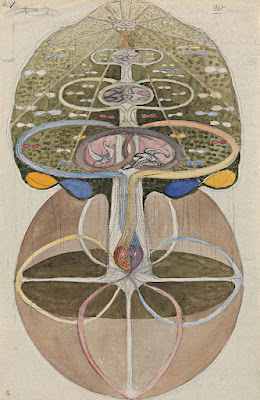 |
| Tree of Knowledge No. 1 by Hilma af Klint, watercolor, et al. on paper, 1913. |
An exhibition of watercolors, painted by a renowned pioneer of Abstract art, opens today in a UES gallery.
Tree of Knowledge features eight paintings by Hilma af Klint (1862-1944), the Swedish painter said to be inspired by Rosicrucian and Anthroposophist thought. The works can be seen by the public, by appointment, at David Zwirner 69th Street. Click here for more information and to schedule a visit.
From the publicity:
David Zwirner is pleased to present Tree of Knowledge, an exhibition of a rare set of Hilma af Klint’s groundbreaking 1913-1915 series of works on paper of the same title, on view at the gallery’s 34 East 69th Street location in New York.
This recently discovered group of eight watercolors is among the few works by the artist to exist outside of the holdings of the Hilma af Klint Foundation.
Though little known during her lifetime and for decades after, Swedish artist Hilma af Klint has come to be recognized as one of the most important and inventive artists of the twentieth century. When she began making vibrant, symbolic paintings as early as 1906, her work was radically unlike anything that had come before, and preceded the abstract work of artists such as Wassily Kandinsky, Piet Mondrian, and Kazimir Malevich by several years.
In the early 1920s, af Klint gave the set of watercolors as a gift to Rudolf Steiner, the founder of the spiritual and philosophical movement known as Anthroposophy, which influenced her. Around 1927, the works came into the possession of Albert Steffen, who became president of the Anthroposophical Society after Steiner’s death in 1925.
It was not known that af Klint had made two versions of the Tree of Knowledge suite (the other is in the holdings of the af Klint Foundation) until the recent re-discovery of this set in the Albert Steffen Stiftung, Dornach, Switzerland. It is currently owned by a private collector.
On the occasion of the exhibition, David Zwirner Books will publish a fully illustrated catalog around this body of work with a newly commissioned essay by celebrated af Klint scholar Julia Voss, whose comprehensively researched af Klint biography is forthcoming from the University of Chicago Press in September 2022.
Accompanying this exhibition, David Zwirner Online will present an Exceptional Works online viewing room exploring the history behind this remarkable set of watercolor works on paper.
I missed the Guggenheim exhibition a few years ago, but I don’t want to miss this. I’m going to alert the Anthroposophical Society too.
Monday, November 1, 2021
‘Royal Arch tartan unveiled’
Saint Andrew’s Day comes on the last day of this month, so what better time to show off the new tartan designed for Royal Arch Masonry?
I don’t wear kilts myself—I don’t have the legs to pull it off—but don’t let that stop you from sporting this duly registered pattern. I guess in time there’ll be scarves, hats, socks, and whatever made. The rule, to wear this tartan, is one must be a Royal Arch Mason affiliated with the General Grand Chapter of Royal Arch Masons International.
The Scottish Register of Tartans defines the color scheme:
The colors are symbolic of Royal Arch Masonry in the United States. Dark red represents the General Grand Chapter. Red represents the constituent chapters and members. The four yellow bands represent the four degrees in the American York Rite. The blue, purple, red, and white colors together represent the banners found in a Royal Arch Chapter.
Some of that went over my head, but it’s official and in the National Records of Scotland as of September 28.
Subscribe to:
Posts (Atom)





